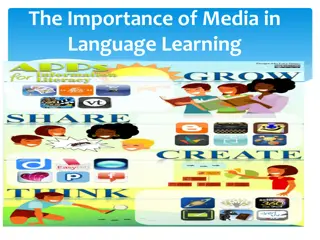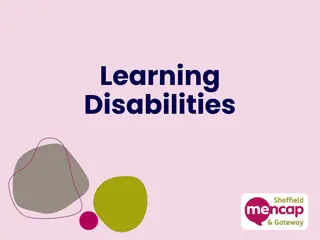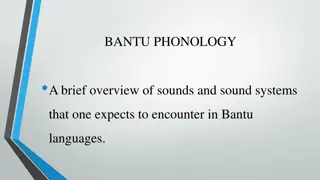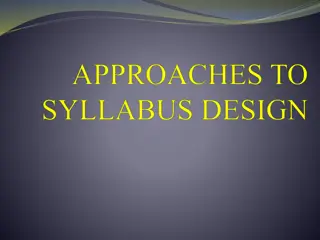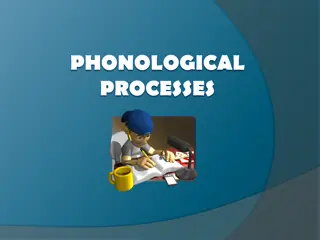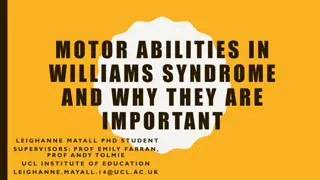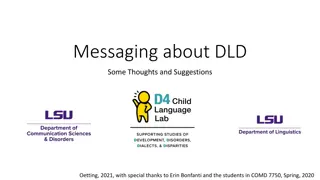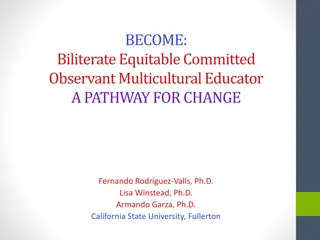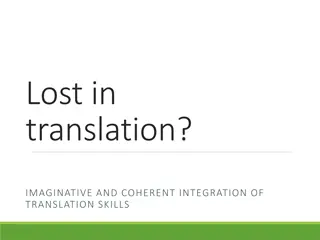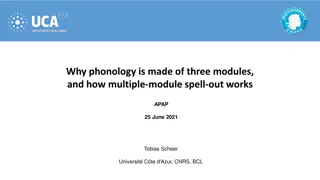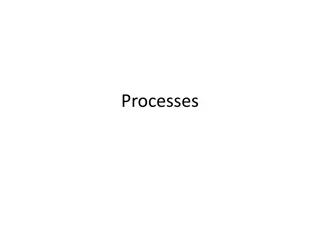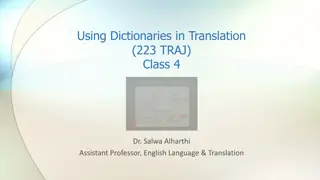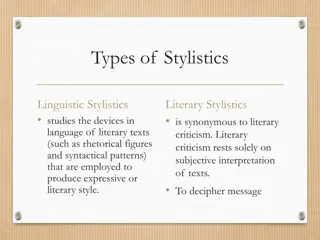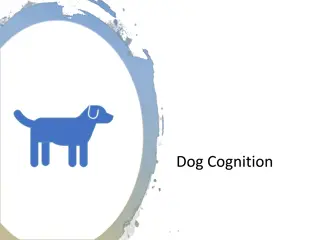Linguistic Abilities and Learning Processes
Learner corpora research in psycholinguistics explores the processes behind textual products, focusing on the linguistic abilities of creators and the learning processes influencing those abilities. Combining psycholinguistic theory with corpus analysis helps establish connections between language use and cognitive mechanisms, shedding light on how individuals acquire language skills and preferences.
Uploaded on Feb 25, 2025 | 1 Views
Download Presentation

Please find below an Image/Link to download the presentation.
The content on the website is provided AS IS for your information and personal use only. It may not be sold, licensed, or shared on other websites without obtaining consent from the author.If you encounter any issues during the download, it is possible that the publisher has removed the file from their server.
You are allowed to download the files provided on this website for personal or commercial use, subject to the condition that they are used lawfully. All files are the property of their respective owners.
The content on the website is provided AS IS for your information and personal use only. It may not be sold, licensed, or shared on other websites without obtaining consent from the author.
E N D
Presentation Transcript
Learner corpus research and psycholinguistics Phil Durrant
Why psycholinguistics & learner corpora? Corpora are collections of textual products We want to draw conclusions about processes behind them: about the linguistic abilities of their creators about the learning processes which explain those abilities Psycholinguistic theory and methods may help make these links
A caveat Writing is a mental activity or process resulting from the interactions of multiple cognitive subprocesses (Zhang & Dean, 2015) Too strong: texts are not just products of cognition But they do entail cognitive processes
COMPARING CORPUS LINGUISTICS AND PSYCHOLINGUISTICS
Corpus Research Psycholinguistic Research Focus on language in use, emphasis on social contexts Focus on mental processes/representations
Corpus Research Psycholinguistic Research Focus on language in use, emphasis on social contexts Focus on mental processes/representations Large samples: Representative/balanced Emergence of large-scale patterns Small samples Frequently biased
Corpus Research Psycholinguistic Research Focus on language in use, emphasis on social contexts Focus on mental processes/representations Large samples: Representative/balanced Emergence of large-scale patterns Small samples Frequently biased Naturalistic (high contextual validity) Correlational Tightly controlled (high construct validity) Experimental
Corpus Research Psycholinguistic Research Focus on language in use, emphasis on social contexts Focus on mental processes/representations Large samples: Representative/balanced Emergence of large-scale patterns Small samples Frequently biased Naturalistic (high contextual validity) Correlational Tightly controlled (high construct validity) Experimental Exploratory Theory-testing
Corpus Research Psycholinguistic Research Focus on language in use, emphasis on social contexts Focus on mental processes/representations Large samples: Representative/balanced Emergence of large-scale patterns Small samples Frequently biased Naturalistic (high contextual validity) Correlational Tightly controlled (high construct validity) Experimental Exploratory Theory-testing Focus on products, abstracted from communicative processes. Focus on online processes (comprehension/production as it happens)
Corpus Research Psycholinguistic Research Focus on language in use, emphasis on social contexts Focus on mental processes/representations Large samples: Representative/balanced Emergence of large-scale patterns Small samples Frequently biased Naturalistic (high contextual validity) Correlational Tightly controlled (high construct validity) Experimental Exploratory Theory-testing Focus on products, abstracted from communicative processes. Focus on online processes (comprehension/production as it happens) Rejection of performance/competence dichotomy Emphasis on frequency
THEORY INTEGRATION METHOD INTEGRATION
Blom, Paradis & Duncan (2012) Correct use of 3SG inflection in obligatory contexts predicted by: Type/token frequency of 3SG in input Allomorph frequency Child s vocabulary size Role of inflection in L1 All predictors contribute significantly to 3SG inflection
Two types Proposing a theory: Sinclair s (1987) idiom principle / Hoey s (2005) lexical priming. Interpreting findings in terms of existing theory: Reilly et al (2005): increased use of distancing devices with age Due to development of prefrontal cortex > increased executive function > ability to consider multiple perspectives > linguistic structures associated with multiple concepts
Theoretical integrations: Potential strengths Naturalistic, large-scale data Clear theoretical basis for inferences Development of new hypotheses
Theoretical integration: Potential problems Introjection (Lamb, 2000) Correlational data Aggregation of data from different learners
Millar (2011) Is formulaic language easier to comprehend than novel utterances? Learner collocations used as stimuli for self-paced reading task. Reading times greater for learner collocations.
Payne & Ross (2005) Does working memory influence gains from CMC course? Corpus of course data plus WM tests Greater gains in volume of language produced associated with low phonological working memory but high central executive.
Triangulation Multi-centre: e.g., nature of multi-word expressions (Siyanova- Chanturia & Martinez, 2015) Single-centre: e.g. do L2 learners acquire collocations from input in a frequency-based way? (Durrant & Schmitt 2009, 2010; Durrant 2014)
Durrant & Schmitt 2009 Learner corpus study Naturalistic Assumes BNC represents learner input High-frequency collocations are overused Large scale Assumes use reflects knowledge High MI collocations are underused
Durrant & Schmitt 2009 Learner corpus study Naturalistic Assumes BNC represents learner input High-frequency collocations are overused Large scale Assumes use reflects knowledge High MI collocations are underused Durrant & Schmitt 2010 Lab-based recall study Control over input Unnatural Collocations learned implicitly; repetition increases learning Sensitive measure of knowledge formation Small scale
Durrant & Schmitt 2009 Learner corpus study Naturalistic Assumes BNC represents learner input High-frequency collocations are overused Large scale Assumes use reflects knowledge High MI collocations are underused Durrant & Schmitt 2010 Lab-based recall study Control over input Unnatural Collocations learned implicitly; repetition increases learning Sensitive measure of knowledge formation Small scale Durrant 2014 Meta-analysis of collocation tests Large scale Based on recall/recognition data only High-frequency collocations are well known. Multiple research sites High MI does not promote learning
Method integration: potential strengths Inclusion of different types of construct Multiple perspectives Complementarity of strengths/weaknesses
Method integration: potential problems Authenticity of corpora; authenticity of data Validity of frequency information Coherence of constructs
THEORY INTEGRATION METHOD INTEGRATION
References Blom, E., Paradis, J. & Duncan, T.S. (2012). Effects of input properties, vocabulary size, and L1 on the development of third person singular s in child L2 English. Language Learning, 62(3), 965-994. Durrant, P. & Schmitt, N. (2009). To what extent to native and non-native writers make use of collocations? International Review of Applied Linguistics, 47(2), 157-177. Durrant, P. & Schmitt, N. (2010). Adult learners retention of collocations from exposure. Second language research, 26(2), 163-188. Durrant, P. (2014). Corpus frequency and second language learners knowledge of collocations. International Journal of Corpus Linguistics, 19(4), 443-477. Hoey, M. (2005). Lexical Priming: A new theory of words and language. London: Routledge. Lamb, S. (2000). Bidirectional processing in language and related cognitive systems. In M. Barlow & S. Kemmer (Eds) Usage-based models of language. Stanford: CSLI Publications. 87-119.
References Millar, N. (2011). The processing of malformed formulaic language. Applied Linguistics, 32(2), 129- 148. Payne, J.S. & Ross, B.M. (2005). Synchronous CMC, working memory, and L2 proficiency development. Language learning and technology, 9(3), 35-54. Sinclair, J. (1987). Collocation: a progress report. In R.Steele & T.Threadgold (Eds) Language topics: Essays in honour of Michael Halliday. Amsterdam: John Benjamins. 319-331. Siyanova-Chanturia, A. & Martinez, R. (2015). The idiom principle revisited. Applied Linguistics, 36(5), 549-569. Zhang, M. & Dean, P. (2015). Process features in writing: Internal structure and incremental value over product features.ETS-RR-15-27.



